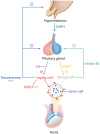Cryptorchidism and puberty
- PMID: 38532895
- PMCID: PMC10963523
- DOI: 10.3389/fendo.2024.1347435
Cryptorchidism and puberty
Abstract
Cryptorchidism is the condition in which one or both testes have not descended adequately into the scrotum. The congenital form of cryptorchidism is one of the most prevalent urogenital anomalies in male newborns. In the acquired form of cryptorchidism, the testis that was previously descended normally is no longer located in the scrotum. Cryptorchidism is associated with an increased risk of infertility and testicular germ cell tumors. However, data on pubertal progression are less well-established because of the limited number of studies. Here, we aim to review the currently available data on pubertal development in boys with a history of non-syndromic cryptorchidism-both congenital and acquired cryptorchidism. The review is focused on the timing of puberty, physical changes, testicular growth, and endocrine development during puberty. The available evidence demonstrated that the timing of the onset of puberty in boys with a history of congenital cryptorchidism does not differ from that of non-cryptorchid boys. Hypothalamic-pituitary-gonadal hormone measurements showed an impaired function or fewer Sertoli cells and/or germ cells among boys with a history of cryptorchidism, particularly with a history of bilateral cryptorchidism treated with orchiopexy. Leydig cell function is generally not affected in boys with a history of cryptorchidism. Data on pubertal development among boys with acquired cryptorchidism are lacking; therefore, more research is needed to investigate pubertal progression among such boys.
Keywords: Leydig cell; Sertoli cell; germ cell; testicular size; testosterone; undescended testis.
Copyright © 2024 Rodprasert, Virtanen and Toppari.
Conflict of interest statement
The authors declare that the research was conducted in the absence of any commercial or financial relationships that could be construed as a potential conflict of interest.
Figures


References
Publication types
MeSH terms
LinkOut - more resources
Full Text Sources
Medical

